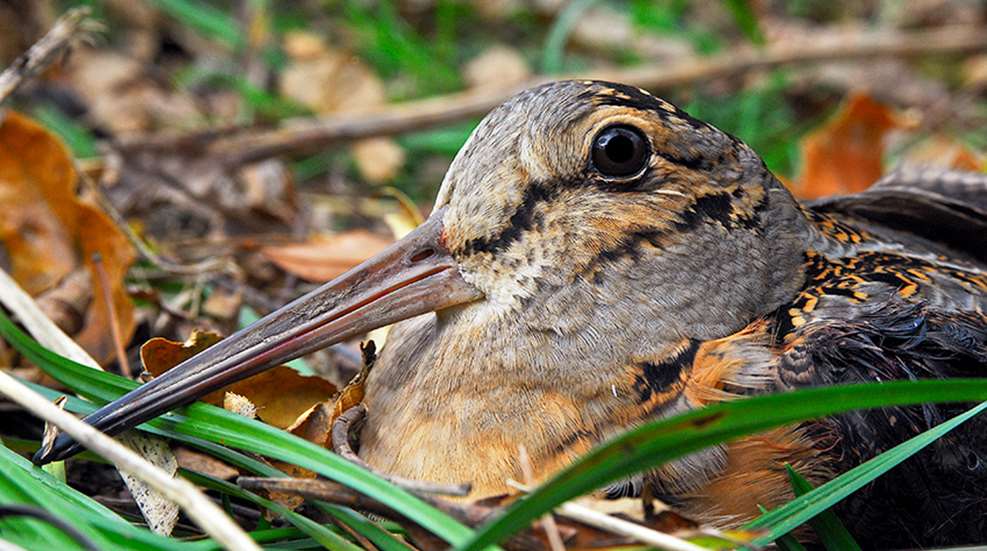
Class is subjective. Its definition is in large part determined by the individual, and others may not concur with those characteristics assigned by that individual to designate class. But hunting in New England likely tilts the odds in favor of selecting this pursuit as a classy endeavor. Add to the mix an Old Hemlock setter and shotguns from earlier, more genteel times, and the most jaded can hardly refuse at least a nod of intrigue. It was this intrigue that first took me to Vermont’s Northeast Kingdom.
The Northeast Kingdom comprises the northeast corner of Vermont. The name is attributed to former Vermont governor and U. S. Sen. George D. Aiken, who used the term in a 1949 speech. Vermonters often refer to it simply as The Kingdom. It is bordered on the east by the Connecticut River and on the west by the Green Mountains. The Kingdom covers 2,027 square miles; 80 percent of it is forested.
Moose are the largest species found in the area, and black bears are quite common. Sign of these, in the form of droppings, tracks, scarred trees or even occasional sightings, is something the visitor can expect. Deer and wild turkeys are present as well, as is a long list of smaller game and non-game species. While such animals as just outlined provide the potential for additional excitement, we were in the Northeast Kingdom looking for woodcock.
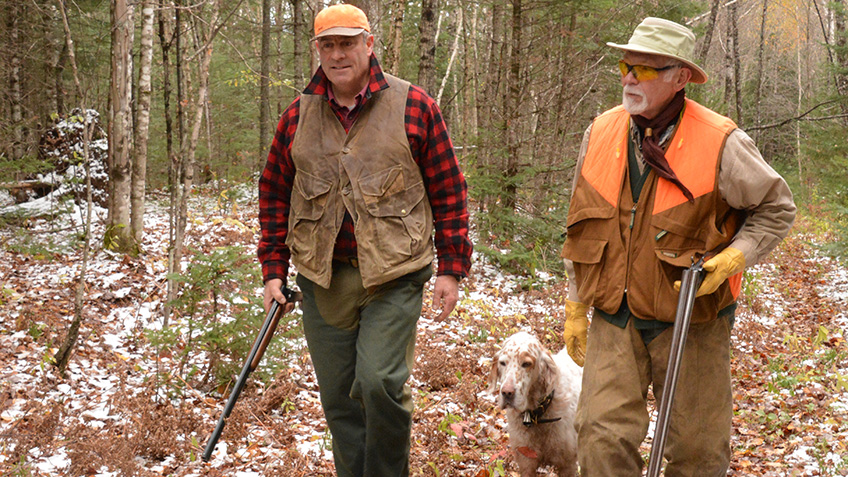
Much of the woodcock habitat in this country is not for aged men and bad knees. It is rock-strewn, choked with vegetation, often wet and thoroughly unforgiving of anyone whose balance has been impacted by too much birthday cake. Still, that one who elects to go will from that point forward be inextricably tethered to this land; will gladly suffer the indignities of falls and subsequent scowls from the less infirmed. That one, year after year, will feel compelled to embrace the pain of just one more sojourn. So here I was again, another year of deterioration to my credit.
That previous year had been quite agreeable. October weather was pleasant, demanding little more than a heavy shirt or light jacket during early mornings. But this year was different. My hunting companion Bryce Towsley got a call from our host, Bob Rose, the evening before our first hunt of this second trip, and he noted that conditions were suspect. The two-hour drive Bryce and I would accomplish predawn the following day would likely show us a hint of winter. Snow and wind, as it turned out, were not far up the road.
We met Bob early that day, and after exchanging pleasantries, began extracting gear from one truck and transferring it to another. Wool mittens were immediately employed as I quickly became aware that I was no longer in Mississippi, where autumn temperatures just two days past were in the short-sleeve category. Instead, I was in a land I had become acquainted with only recently, and one with which I was and am thoroughly enamored. Not as rugged as the Brooks Range nor as remote as Zimbabwe but certainly possessing its own aura of haunting wildness, it is a wildness that speaks softly but adamantly of mystique. Adventure well worth the price of admission was just around the bend.
■ ■ ■
“Dog on point.” Bob’s words came soon after we entered woodcock cover and brought to mind the first time I heard him say the same a year back. The proclamation was a basic acknowledgement and notice to make ready, but it was more. It was a statement of certainty; a bird was there. It was a statement filled with promise, a statement that brought a curious bump to the heart that already had an increased rate from the exertion of crossing streams, negotiating tangles and gulping frigid air to replenish laboring lungs, that air then expelled in ghostly puffs of fog that proved cold a reality. The bird was up and gone before a shotgun rumbled. No fault of the dog, however.
That dog is a marvel, a gentleman. Fionn, who answers without pause to Finn, is of the Old Hemlock breed. His genealogy traces to the work of artist, writer, hunter and dog man George Bird Evans, the leading figure in development of the Old Hemlock. And while I have not had extensive exposure to other members of this breed, it is unthinkable to consider performance more fully developed than that found in Fionn. Descriptors of this canine are unending. But to put it succinctly, he is amazing.
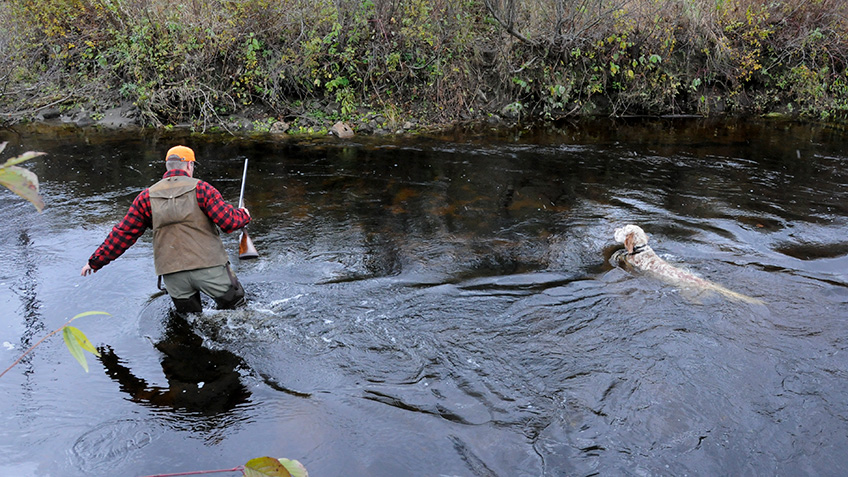
Not far from that first wayward bird, Fionn located another. There was no stream crossing required on this one. Bob outlined a simple plan of who would go where to assure safety, and we eased into the point, an image of grandeur in dog flesh standing there before us. He was much like a statue, like a painting reminiscent of one from brushes of the finest artists. Not even a quiver of excitement, just a rigid stance, nose lowered, and the definite but inaudible message that the bird was right there amidst leaf litter meticulously designed to curtain a woodcock.
And the bird was up, spiraling and zigzagging, his staccato chatter heard even above the din of gusting winds. At the outside edge of a young hemlock, the bird attempted a hard right, but Bryce’s shotgun rumbled. Then a comrade of the downed bird rose and headed in the direction of parts unknown, flushing ahead of the dog on my side maybe 10 yards. He afforded a right quartering shot, ideal for a lefty such as I. We had two birds for two shots.
The little shotgun I was using that morning, though borrowed from Bryce, was a sibling to the one I use at home for doves and quail, a Browning Citori 725 in 20-gauge. It is a joy to shoot, and I find it likes me well enough to do as I ask. But that delightful Citori, I soon learned, would be set aside during the next excursion, replaced by one with more distant history, this thanks to our host.
■ ■ ■
Bob holds a fancy for fine guns, particularly those with ample age. Classics if you will. On the last of a three-bird limit the previous year and precariously close to the end of our hunt, Bob offered me a true treasure.
“Take your last bird with this,” he suggested as he unpacked and handed me a sidelock Purdey 16-gauge, cylinder/improved cylinder that dates back to the late 1800s. I was dumbfounded, mouth open, eyes wide and observant. I took it gingerly. When I thumbed that side lever and the action opened, I saw a ballet. The chambers were now receptive to a duet of 2½-inch low-pressure shells common to English doubles and shorter-chambered American guns. Snicking the action closed was without effort; I heard Debussy’s "Clair de Lune." The Purdey was magnificent, small scars of use only enhancing its grace. Many stories, I am sure, were hidden among those dings.
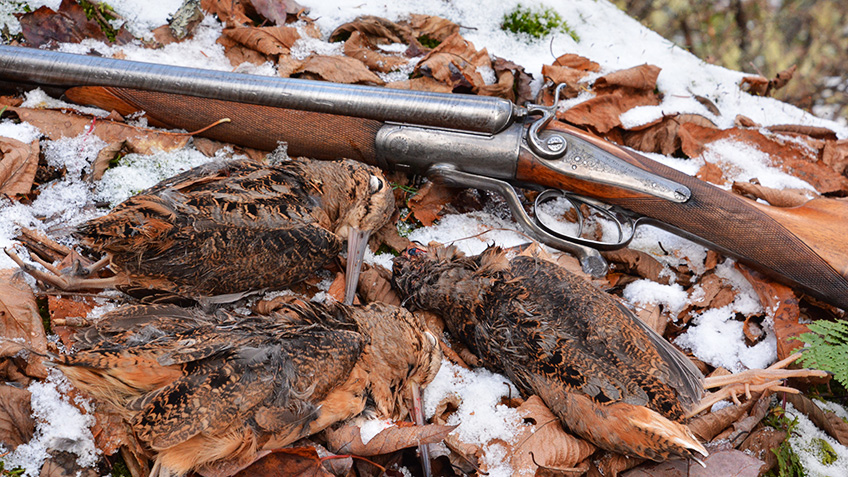
Ahead of us and waiting in ambush, rocks, brush and unyielding grasses demanded all that remained from legs that had begged retirement more than an hour earlier. Then Fionn settled solidly.
Another woodcock took wing and offered that right quartering. The Purdey was at shoulder, bird floating out front of those twin tubes, safety positioned to fire. And I missed. Through a fog of self-loathing and a brain scrambled by the immediacy of the situation, I recalled that this gun was a double trigger. Unlike the single trigger of my over/under, tugging again at the first on this handsome side-by-side would accomplish nothing. My finger slid to the back and my last woodcock of that three-bird limit and of this particular hunt lay at the base of a hemlock. This then was a fitting end to a grand day in an unfamiliar setting with an historic shotgun, gracious companions, a superb dog and a unique game bird.
"After years of contemplating such matters, I have come to seriously consider the possibility that truth is within that moment of the missed shot."
I walked over and picked up the woodcock. It was indeed an admirable creature. Curious though. Eyes behind the ears; a long bill with prehensile tip; a brain that seems to be upside down. But the entirety of this little specimen is designed to function well. That mottled plumage allows it to virtually disappear; the erratic flight pattern gives it a near magical ability to avoid contact with a charge of shot. I stood there considering how I could respect and give honor to this bird while at the same time interrupting the drama known as life. That answer, I suppose, is determined by each individual. But I did respect and honor.
To say that these three birds of that first hunt were the only ones I had ever encountered would be a falsehood. Since they migrate to areas in the South near the Gulf Coast, my home turf of Mississippi holds a scattering of them in winter. During childhood, quail were common; we hunted them religiously. Invariably, we bumped a woodcock from time to time, our ragtag pointers seeming to know little about how to handle such situations. Still, we took a few woodcock as opportunities arose. But this hunt in the Northeast Kingdom was the first done in proper fashion, that New England approach I had read about, the way it should be done. I was aptly captivated. I remain so.
■ ■ ■
The following year, that year referenced at the beginning of this piece, was marked by a similar regimen as the first, other than inclement weather. I started it off with the borrowed Citori but traded on the afternoon hunt for another one of Bob’s treasures. This one was a W. Richards double, 20-gauge hammer gun with 28-inch barrels of nitro-proofed Damascus and 2½-inch chambers. It hosted a Jones rotary under lever and was choked cylinder/cylinder. This unit with ¾-ounce loads of No. 8’s is ideal for New England coverts holding grouse and woodcock, and I was eager to use it for a few hours of hunting action.
A change of locations put us in an area of snow-covered hills that required cautious navigation to access a bottom. That bottom should hold woodcock. Blustery winds were disagreeable, but those tangles downslope looked most promising. And based on our discovery of droppings and paw prints as we entered that bottom, bears apparently favored this patch of cover as well. Fionn was immediately hard at work. In fact, he froze in fine form within minutes. Time came to stuff shells into shotgun chambers, but my fingers were so numb I could hardly complete such a rudimentary task.
This scene was closer to simple than most woodcock covert. There was actually an opening in the canopy, and it stretched 30 yards or so in a relatively straight line. If the bird at Fionn’s nose opted for clear sailing, that opening would afford a shot even the novice could make. Little need for shotgun expertise here. Just raise the gun and press the trigger. And as hoped, the bird elected that path of least resistance, directly away from me, straight ahead. Bryce was to the right; Bob behind and content as spectator. I fumbled and was swallowed in angst, lost any semblance of concentration. Likely, I slapped the trigger before that graceful little 20 clinched in brittle hands ever settled into that pocket of my shoulder. A blatant, unquestioned miss. Then silence.
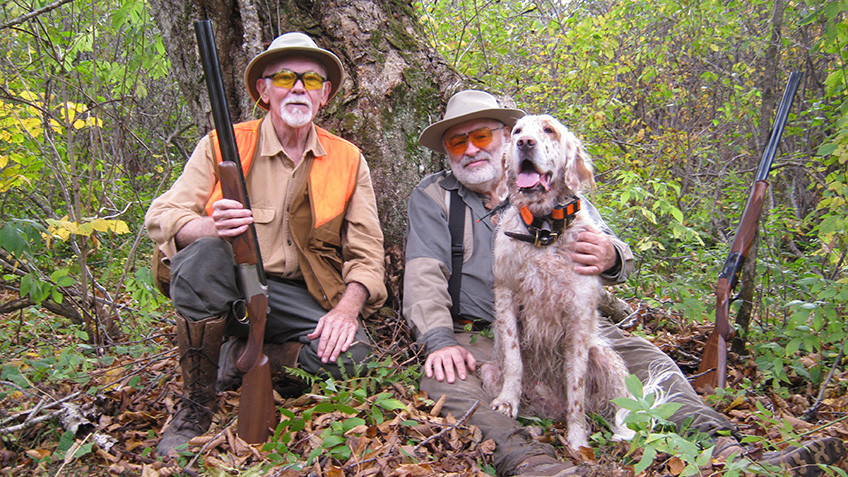
After years of contemplating such matters, I have come to seriously consider the possibility that truth is within that moment of the missed shot. Truth, contrary to what we too often suspect, is not so much in that moment of revelry when all goes well as it is in that moment when all, on the surface anyway, goes poorly. Truth resides in what initially appears to be wasted effort, thrives in the aching core. For truth gives us pause to reflect on basics, basics of shooting, basics of living. Effort minus results is not always wasted. That effort has possibly strengthened us. That aching core has possibly prompted us to examine who and what we really are. Missed shots are seldom the end. They are more likely bumps along the way reminding us to keep our eyes on the target. Reminding us to replay the basics.
I was suddenly snatched from this worrisome habit of thinking by the words, “Dog on point.” This announcement, by that second year and after many rambles in woodcock habitat, had become expected and always welcomed. We, all three of us, took assigned stations. A bird went up. It was Bryce this time. He handled the maneuver in his customary fashion, smoothly and with practiced resolve. He had a bird. And then my turn a bit later. This woodcock was high and right but intersected an opening at the same time as did the No. 8’s. Shadows were now beginning to slant toward late afternoon.
And Fionn found another. This one was similarly positioned as the one I missed earlier. An opening again, another straight away and one without cluttered cover. My first shot was less than sensational, but the second was efficacious. “Right up there beyond that grass,” I pointed as Bob walked with Fionn in that direction. The dog made a gentle pick-up and delivered the last woodcock of that day to his master’s hand.


































